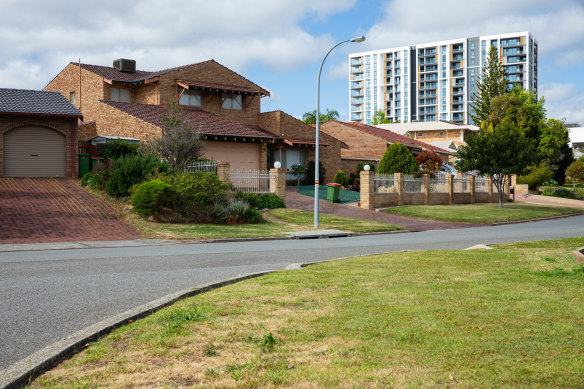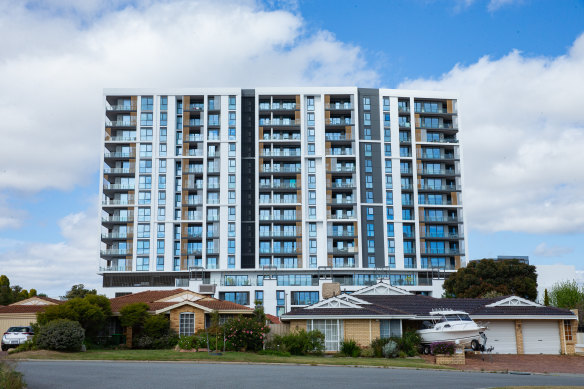High-density plans cast a shadow over Booragoon’s leafy streets
Booragoon residents say the character of their quiet suburban streets will be irreparably damaged if their council forges ahead with plans paving the way for higher density development in the area.
The City of Melville has proposed changes to its local planning scheme that would allow apartments four storeys or higher in streets located in the shadow of the Westfield Booragoon Shopping Centre.

Homeowners along a suburban street in Booragoon are concerned about a proposal to increase density. Credit: Ross Swanborough
The Scentre-owned shopping centre is due for expansion next year.
The Ramble resident Kim Thomson bought her property in 2022 and said it was “confronting” that the street she lived on, considered part of the dress circle of Booragoon, had been earmarked for increased density from R20 to R40 on one side of the street, and R40 to R100 on the other side of the street.
“R100 is a drastic increase for a suburban street, especially one with a primary school on it,” she said.
“This is not a run-down area requiring refurbishment, it is a well established street which already includes many strata properties and one of the higher R-codes within the suburb.
“We understand urban infill is a much-needed requirement for the housing crisis in Perth but the council’s pursuit to liberally increase R-codes throughout the City of Melville seems like a cavalier and irresponsible method to increase density at the cost of the livelihoods of the current residents.”
Thomson was concerned by dropping home values, increased traffic, construction noise, loss of privacy and tree canopy.
In a failed notice of motion to council at its September ordinary meeting, Cr Clive Ross called for the city to investigate boosting infill around the Murdoch and Bull Creek train stations, which aligned with the state government’s objective to add higher density around public transport hubs.
Ross said land prices around the stations were lower and could facilitate affordable housing.
“The City of Melville has been set a target of just over 18,000 new dwellings by 2051,” he said.
“Apart from the Canning Bridge Activity Centre the City is well behind the target and needs to identify and approve development in areas which are already serviced by electrified mass public transport.”
Melville Mayor Katy Mair told ABC Radio’s Nadia Mitsopoulos that the ongoing review of the local planning scheme had identified the train station precincts as areas to be investigated for future development.
However, she said staff were currently too busy to investigate zoning changes around the train stations due to the scale of work needed to finalise the overdue local planning scheme, as well as the public open space strategy and Canning Bridge activity centre review. The process could take five years, she claimed.
“We acknowledge that there is community interest around development opportunities for residential areas surrounding the Bull Creek and Murdoch train station precincts,” Mair said.
“The stations have both been identified as priority sites for future strategic planning as part of the city’s review of its local planning scheme, and they remain important considerations in the city’s strategic land-use planning priorities.”

Amara looms over detached houses in Booragoon. Credit: Ross Swanborough
Ardross resident Graeme Price said urban infill was needed, but not in a way that destroyed the character of suburbs.
He was shocked to hear the city was not looking at high density around the train stations due to the lack of connectivity and staff time.
“The state government is advocating for urban high-density development around train stations; however, the city would rather obliterate the characterful beauty of Ardross and its unique topography, tree canopies and landscape.”
Density is already on the increase in the area, with the 14-storey luxury Amara City Gardens completed in 2022 opposite Westfield Booragoon shopping centre.
Planning Minister John Carey, who gets the final say on the City of Melville scheme, said all tiers of government had a role to play in boosting housing supply.
“The Melville City Centre, which includes Booragoon, is recognised by the council as an important precinct for housing growth and development,” he said.
“Plenty of other councils across WA have undertaken the necessary planning and consultation to ensure their local planning schemes are up-to-date and fit-for-purpose to meet the needs of their communities for now and into the future.”
WA will fail to meet its share of the National Housing Accord target unless it dramatically increases its home completion rate, the Property Council WA warned on Wednesday.
Australian Bureau of Statistics data released showed only 3957 homes were built across WA in the 2024 June quarter.
The June quarter’s home completions were also a drop from the 4305 completions recorded in the previous March quarter.
Overall, 130,000 new homes need to be built in Western Australia during the National Housing Accord reporting period, from July 2024 to July 2029.
Executive director Nicola Brischetto said WA simply wasn’t building enough homes.
“WA needs to be building 6540 new homes each quarter to complete our fair share of the National Housing Accord,” she said.
“The state hasn’t achieved that many new home completions in a single quarter since December 2016.”
Mair said without medium and high density developments, the State Government’s target of 18,000 new dwellings in the City of Melville by 2050 would not be possible.
“An estimated 3000 additional dwellings have been built in the City since 2010 and if housing is continued to be delivered at this rate, the City would reach 50 per cent of its infill target by 2050,” said Mayor Mair.
Start the day with a summary of the day’s most important and interesting stories, analysis and insights. Sign up for our Morning Edition newsletter.